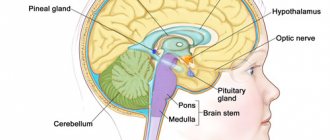Vascular hemangioma is a tumor that grows from the tissue of blood vessels. Such a formation is classified as a tumor process that is not related to cancer. The cause of the disease is often congenital venous abnormalities.
Such formations will be able to be localized in various areas of the vascular network. A feature of this formation is rapid growth. After surgery, the pathology may reappear. Pathology can be found in children and adults of various ages.
The problem is visible to the naked eye
Modern scientists have not yet been able to identify the true cause of the development of the disease. The mechanisms of tumor growth from blood vessels have not yet been determined.
Often this formation is detected in children during the neonatal period. Hemangioma in this case becomes a significant cause for concern.
Manifestation of the disease on the lips.
What it is?
The term hemangioma comes from the Greek words “haima” - blood and “angeon” - vessel. This is what doctors call a benign neoplasm, which is formed from small and large blood vessels.
Tumors are most often localized to the skin, but can occur in other organs and systems, for example, in the liver, bones, and muscle tissue.
The basis of the neoplasm is atypical cells and elements of blood vessels. Visually, it looks like a small reddish spot, the shade of which can vary from light pink to burgundy.
As the child grows up, hemangioma on the skin can either disappear over several years or grow progressively. In this case, accelerated tumor growth is observed in premature or low birth weight children.
What does a vascular tumor look like?
In more than 80% of cases, hemangiomas in infants are localized on the skin. The neoplasms look like vascular dots or many elements merged into one spot. The color depends on which vessels are affected and can be light pink, burgundy, purple or bluish.
To the touch, the spot can be absolutely smooth and even, slightly raised above the surface of the skin or lumpy. The shape of the hemangioma is usually regular, round or oval with clear, even edges. A child may have one hemangioma or several vascular spots on his body.
Superficial neoplasms affect the skin 2-4 mm deep. Subcutaneous are cavities filled with blood and usually involve more than 5 mm from the surface of the skin.
The size of the formation can also vary from a few millimeters to 15-20 centimeters in diameter.
The main signs of hemangioma, distinguishing it from other red neoplasms, such as nevi or port-wine stains, are:
- The skin temperature above the surface of the vascular neoplasm is slightly higher than around it.
- When you press on the hemangioma with a finger or a piece of glass, it turns pale, and when the pressure stops, it gains color again.
- When the newborn screams, cries, strains, or experiences any other stress, the vascular tumor darkens and can change from pink to bright red or burgundy.
- The most common localization is the scalp, face, and neck.
- Vascular tumor is more common in girls than in boys.
It is noted that hemangioma is characterized by the fastest growth rate among all benign tumors.
Causes
The causes of vascular tumors in newborns and adults are currently not fully understood.
There are several theories of their occurrence:
- The influence of unfavorable environmental conditions on the mother’s body while carrying a child, including the abuse of bad habits (smoking, alcoholic drinks).
- Hormonal imbalances, metabolic disorders, taking hormonal drugs during pregnancy.
- Diseases suffered by the expectant mother include acute respiratory viral infections, influenza, childhood infections, as well as allergic reactions to medications. The impact of these factors is especially unfavorable in the first 8 weeks of pregnancy.
The common cause is considered to be hypoxia, that is, a lack of oxygen in the cells and tissues of the fetal body at the stage of formation of the cardiovascular system.
Factors that increase the risk of hemangioma in an infant include:
- Late birth (mother's age over 35 years).
- Multiple pregnancy.
- Low birth weight of the baby (less than 3000 g for full-term pregnancy).
- Premature birth (due to poor lung development, the baby may experience oxygen starvation, which provokes the development of vascular abnormalities).
- Complicated pregnancy (preeclampsia, eclampsia, placental insufficiency).
- Injuries during childbirth (quick, rapid labor, weakness of labor and prolonged labor, entanglement in the umbilical cord).
The influence of hereditary factors on the incidence of hemangiomas in infants has also been noted.
In an adult
Vascular tumors in adults are extremely rare and usually pose a greater health risk than infantile hemangiomas.
The appearance of neoplasms on the skin in adolescents and older adults can be caused by:
- Hereditary predisposition. The appearance of this tumor is more likely in people whose immediate relatives have experienced hemangioma.
- Exposure to ultraviolet rays (excessive tanning, solarium, neglect of sunscreen, sunburn).
- Negative environmental influences (living in large industrial cities, near factories), bad habits (especially smoking).
- Impaired function of the cardiovascular system (hypertension, coronary artery disease, heart failure), diseases of internal organs, pathologies of the endocrine system (diabetes mellitus, thyroid disease).
If a hemangioma occurs in adulthood, it is important not to wait until the vascular tumor goes away on its own, but to consult a doctor as soon as possible. Unlike children, the treatment strategy for hemangiomas in adults rarely includes a wait-and-see approach; all such tumors must be removed.
In children
Since the basis of the theory of the occurrence of hemangiomas in children is impaired blood supply and hypoxia, according to statistics, doctors attribute viral infections suffered by the mother to the most common causes of their occurrence. These can be ARVI (rhinovirus, enterovirus and adenovirus infections), parainfluenza, influenza, herpes. Hemangioma may also be associated with the use of certain medications and an allergic reaction to them in the expectant mother during pregnancy. That is why doctors advise pregnant women to be attentive to their own health and not to self-medicate for colds.
Another theory for the appearance of hemangiomas in newborns is the influence of increased estrogen levels in the mother’s blood during pregnancy. This can be caused by hormonal imbalance, certain types of tumors, as well as unintentional use of combined oral contraceptives and other hormonal medications in the early stages of pregnancy, when the woman is not yet aware of the pregnancy.
Kinds
There are many types of vascular tumors that can develop in both newborns and adults. Depending on the location, hemangioma of the skin, liver, bones, blood vessels, internal organs, and hemangioendothelioma are distinguished.
By origin, the pathology can be capillary, arterial, venous or mixed.
Experts also identify a combined vascular tumor, which is a combination of simple and cavernous hemangiomas.
Cavernous
Cavernous cutaneous hemangioma can be single or multiple. It is based on mature vessels and cavities. Visually, the tumor rises above the surface of the skin, has an uneven surface, warm to the touch, and soft in consistency.
Cavernous hemangioma is one of the most common neoplasms in childhood. Most often localized on the face, it can be located on the neck and mucous membranes.
After birth, cavernous hemangioma usually grows actively during the first year of life.
If the tumor is not treated, it can be complicated by inflammation of vascular tissues or bleeding, or grow into tissues or organs.
Capillary
Capillary hemangioma is a red or purple tumor, round in shape with clear edges. It is formed by small capillaries, some of which have narrowed excessively, while the rest remain in a normal state. Such a neoplasm can appear immediately after birth or develop in utero.
Most often, capillary hemangiomas are located on the wings of the nose, on the cheeks, eyelids, mucous membranes of the mouth or genitals.
Unlike a cavernous type tumor, capillary hemangioma rarely reaches gigantic sizes and does not affect surrounding tissues and organs during growth.
One type of neoplasm is senile vascular tumor. Such dark burgundy areas on the skin of older people are otherwise called senile angioma or Campbell de Morgan spots. They resemble moles in appearance, but instead of the melanin pigment, they are based on an abnormal proliferation of blood vessels. The shape can be oval, round, spherical, the diameter of the neoplasms ranges from 2 to 6 mm.
Senile moles begin to appear at the age of 30-40, and over the years their number increases and their size increases. Favorite localizations are the face, neck, torso and arms.
Senile hemangiomas themselves are not dangerous and rarely lead to any complications, but the appearance of a large number of red moles or a rapid increase in the size of existing tumors is a reason to consult a doctor and check the function of internal organs. It is also necessary to consult with a specialist in case of accidental injury to the tumor or its thrombosis and inflammation.
Venous
This type of hemangioma develops from venous vessels. Visually, the neoplasm is a rounded papule of dark burgundy, purple or bluish color. Most often, venous hemangiomas develop on the skin of the face, lips, and ears in patients over 50 years of age.
The structure of the tumor is a wide cavity formed by a venous vessel, lined from the inside with a thin layer of endothelial cells, filled with red blood cells.
When this type of neoplasm appears, it is important to consult a doctor for examination and differential diagnosis with melanoma and telangiectatic granuloma.
Venous hemangioma in older people rarely leads to health problems and usually causes only aesthetic discomfort.
Usually, the tumor is removed using a laser or electrocoagulation; venous hemangioma is rarely excised.
Arterial
Arterial hemangioma is a benign neoplasm that originates from arterial blood vessels. It can be located in the thickness of the skin, soft tissues and on the mucous membrane, for example, in the oral cavity or on the genitals. Arterial hemangiomas can grow into deep tissues and lead to damage to muscles and bones.
The vascular tumor is soft to the touch and has a dough-like consistency. When palpating it, you can feel the pulsation of the tissues, which occurs in time with the heart rhythm. At rest, arterial hemangioma has a bright red, scarlet color; when pressure is applied, the color of the neoplasm fades, and with physical activity it becomes brighter.
Arterial hemangioma requires close attention from medical workers, since it more often than others leads to various complications - ulceration, bleeding.
Mixed
With combined hemangioma, areas of capillary, branched and cavernous structure can be simultaneously observed in one tumor.
In such a tumor there is a simple skin part and a subcutaneous part, represented mainly by caverns. Experts also identify mixed hemangioma, which, in addition to vascular tumor cells, also includes other tissues - connective, muscle, nervous and others.
The appearance depends on what structures the tumor is predominantly represented by. Clinicians include angiofibroma, angioneuroma, hemlymphangioma and other neoplasms as mixed type hemangiomas.
Tumors often affect internal organs and systems, can lead to disruption of their function, and therefore must be removed.
Symptoms
If a nasal hemangioma is located on open areas of the skin, then it usually does not affect the general well-being of a person. This neoplasm can only be determined by changes in the epidermis in the affected area. External manifestations depend on the type and structure of the tumor.
Nasal capillary hemangioma initially appears as a flat red spot. Over time, it grows, becomes convex and acquires a crimson-purple color. The boundaries of the neoplasm are always clearly defined and the surface is smooth. If you press hard on the tumor, its color fades significantly.
Cavernous hemangioma on the tip of the nose looks like a lumpy, convex formation of blue or purple color. Externally, the tumor looks a little like a grape. It can also be localized in the subcutaneous tissue of the wings and sinuses. When you press it, a dent is formed. During physical stress, a rush of blood occurs to the hemangioma, and the tumor becomes larger.
Combined hemangioma can look very different. The appearance of a mixed tumor depends on the predominance of capillary or cavernous elements in its structure.
Hemangiomas of the nasal cavity are much more severe than tumors located on open areas of the skin. Such neoplasms can close the lumen of the nasal passages and significantly complicate breathing. This is accompanied by the following symptoms:
In advanced cases, hearing loss may occur. The appearance of such a symptom means that the tumor has grown into the nasopharynx and blocked the mouth of the auditory tube.
With large hemangiomas of the nasal septum, patients often experience noisy breathing and snoring during sleep. In addition, the neoplasm constantly irritates the mucous membrane. This is accompanied by a runny nose, sneezing and reflex cough. Against the background of breathing difficulties, increased fatigue and headaches appear due to a lack of oxygen in the body.
Localization
Tumors originating from blood vessels can be localized anywhere where capillaries, arteries and veins pass, however, most often they affect the skin.
Experts have determined the most common location of hemangiomas in children, which is based on descending order of frequency:
- The scalp (especially the occipital region, temples).
- Upper and lower eyelids.
- Cheeks and chin area.
- Oral mucosa.
- Skin of the upper body, arms.
- Wings of the nose.
- Mucosa of the genital organs.
- Skin of the lower extremities.
- Internal organs (liver, kidneys).
- Skeletal bones.
Hemangiomas that occur in adulthood are often associated with excessive exposure to ultraviolet radiation, so they usually affect the skin of those parts of the body that are more exposed to sunlight (face, neck, shoulders, arms).
On the skin of the face
In 95% of cases, a simple hemangioma develops on the facial skin of a newborn. If the tumor grows slowly, it does not cause any discomfort to the baby. Typically, such hemangiomas develop during fetal development, i.e. the baby is born with a tumor, which begins to grow immediately after birth up to 1-1.5 years, and then gradually disappears by 5-7 years.
With the rapid growth of a vascular neoplasm on the face, it is important to consult a doctor as soon as possible in order to decide on its removal. This is due to the fact that a tumor located near the eyes or ears can lead to dysfunction of these sensory organs. Hemangiomas in the area of the nose or lips are also dangerous, since their excessive growth can cause serious defects in appearance.
On the head
Hemangiomas of the scalp are common among infants. Typically, neoplasms grow slowly and rarely lead to various complications. The exception is vascular tumors located near the ears. When they grow, they can deform the auricle, damage the eardrum and cause hearing loss.
In addition, for hemangiomas located on the head, especially those that rise above the surface of the skin, there is a high risk of injury when combing or cutting.
On the foot
On the legs of newborns, both simple capillary hemangiomas and vascular tumors of cavernous, venous, arterial and combined types can occur.
On the labia
Hemangiomas are often found on the mucous membranes of the genital organs, in the perineum and anus.
Vascular tumors look like round, small, red or wine-colored formations, often ulcerate, bleed and can suppurate.
Hemangiomas in the genital area are subject to mandatory conservative treatment or removal, since they are associated with a high risk of complications.
Diagnostic measures
To determine the type of tumor, it is worth going through a series of diagnostic measures that will help make an accurate diagnosis and prescribe adequate treatment. To know the volume of the tumor and the degree of its germination into the deep layers of the skin, as well as its presence on internal organs, ultrasound diagnostics is prescribed. If a hemangioma is suspected on the cerebral cortex, an MRI or CT scan is prescribed. To exclude a malignant nature, a sample is taken for histological examination. When the diagnosis is finally made, the doctor determines treatment tactics.
Treatment of cavernous hemangioma is not mandatory, but if the tumor grows or becomes injured, it is advisable to remove it.
Why is it dangerous?
There are many different complications of vascular tumors, which depend on the location, size and growth rate, as well as the type of hemangioma.
The greatest danger is:
- Ulceration. The most common complication of hemangiomas, characterized by rapid, rapid growth. The appearance of ulcers above the surface of the hemangioma is often combined with bleeding from the neoplasm.
- Bleeding. It can be small or abundant, pulsating, depending on which vessels are involved in the formation of the tumor. Usually a cause of great concern for the parents of a patient with a hemangioma, however, such bleeding can easily be stopped by simply pressing a finger wrapped in sterile gauze or bandage.
- Suppuration. The addition of a secondary bacterial infection with the development of an inflammatory process often occurs in small patients with ulcerated hemangioma, especially with improper skin care during this period.
- Impaired function of the sensory organs. With hemangiomas located near the eyes and ears, visual and hearing acuity may decrease. Neoplasms in the nasal area can lead to its deformation and impaired sense of smell.
- Difficulty breathing. Large, rapidly growing hemangiomas in the neck area can cause compression of the respiratory system and disruption of the breathing process.
- Violations of the function of internal organs. Vascular neoplasms that arise in the liver, kidneys or other organs lead to disruption of their normal functioning and metabolic pathologies.
Hemangiomas of large internal arteries and veins are extremely rare. With a rapid increase in size, such tumors can block the lumen of blood vessels and lead to circulatory problems in the baby.
Diagnostics
Diagnosing hemangioma is not difficult; an external examination is enough to see the neoplasm.
In order to differentiate from other, similar conditions, some instrumental and laboratory studies are carried out:
- Ultrasound to determine the depth of location, the degree of penetration into the deep skin layers, the presence of vascular networks and blood flow;
- biopsy to identify the structure of the formation and what tissue it consists of;
- Angiography is prescribed for patients with extensive hemangiomas to understand whether there are any pathological changes in the vessels.
The examination is carried out by a pediatrician or therapist, who refers the patient to a surgeon for consultation and choice of treatment.
How to treat in adults?
The choice of treatment tactics depends on where exactly the tumor is located, as well as current and possible complications, such as:
- If a vascular formation is located near the eyes, consultation with an ophthalmologist is required.
- If the tumor is localized in the neck, it is necessary to evaluate the function of external respiration and consult a pulmonologist.
- If bones, joints, spine and internal organs are affected, an MRI and ultrasound examination will be required.
- Depending on the clinical symptoms, patients may require examination by a cardiologist, neurologist, gastroenterologist or nephrologist.
When treating adults, unlike children, specialists rarely use a wait-and-see approach or conservative treatment. Senile hemangiomas on the skin are usually removed using radical methods for aesthetic reasons.
Currently, tumors can be cured in the following ways:
- Surgical excision using a scalpel. Most often used to remove large cavernous hemangiomas.
- Diathermic coagulation. Cauterization of a vascular tumor using electric current.
- Radiation therapy. Exposure of neoplastic tissue to high doses of ionizing X-ray radiation.
- Sclerosis. Injection of special substances into the tumor that glue its walls together.
- Removal of hemangioma with laser. Soldering of tumor elements together under the influence of a laser beam.
- Cryotherapy. Removal of vascular tumors using ultra-low temperatures.
In difficult cases, for example, when the tumor is deep, its complex structure, large size or difficult to reach location near vital organs, combined treatment is used. Radiation therapy plus cryodestruction, hormone therapy plus surgery may be prescribed.
Conservative treatment
Conservative treatment of hemangiomas is used mainly to get rid of tumors in childhood. It has been noted that about 90% of vascular tumors in infants respond to therapy with the beta blocker propranolol.
In most newborns, the initial effect of the drug is visible within a few hours after use. The color of the tumor becomes paler, its blood supply decreases, and the hemangioma decreases in size. The drug can be given orally to children; side effects such as anxiety and digestive upset are rare.
In most cases, the tumor disappears during treatment, however, to achieve a lasting result, therapy should be continued for one year.
Systemic and local corticosteroids - Prednisolone, Hydrocortisone - can also be used to treat the tumor.
It is important to remember that oral steroids lead to a decrease in immunity, therefore, during treatment with these drugs, some vaccinations are contraindicated, and you should also avoid contact with sick people and public places during epidemics.
Surgical intervention
A treatment method such as surgery is not a priority. Due to the effectiveness and good cosmetic effects of other removal methods, as well as the high chance of spontaneous disappearance of the tumor in infancy, hemangiomas are rarely removed with a scalpel.
Doctors may recommend surgical intervention in the following cases:
- If it is impossible to use other methods of removal in case of a pronounced cosmetic defect. In this case, the operation is performed so that in the future the child does not have facial disfigurement and associated psychological problems.
- There is a high probability of developing complications, with the risk of loss of functionality of internal organs.
- As an emergency situation in case of compression of the respiratory tract by a tumor, blockage of the lumen of blood vessels, disruption of the liver and kidneys.
- If previous treatments are ineffective.
In the case of incomplete independent regression of infantile hemangiomas, it is possible to treat the remnants of the tumor in a 5-7 year old child, when changes in the tumor are no longer expected. Surgery is also used when the tumor reappears after conservative treatment.
X-ray
X-ray therapy, as one of the methods of radiation therapy, is widely used to treat some types of hemangiomas. Most often, this method is used for deep-lying tumors or their hard-to-reach localization, for example, in the orbital area or retrobulbar space. X-ray treatment is also used for large tumors when surgery is not possible.
The main disadvantage of X-ray therapy for hemangioma is that during the procedure, healthy tissue is affected, and dryness, peeling, and skin atrophy may occur. That is why this method is rarely used to treat children and is usually used in adult practice.
Treatment in a child
In the treatment of hemangioma in newborns, the same techniques are used as in adults. Point and small vascular neoplasms on the skin can be removed using electrocoagulation, cryodestruction or laser exposure.
Small cavernous and mixed hemangiomas respond better to sclerotherapy.
For large tumors or their deep location, preference is given to surgical excision or embolization, that is, blocking the lumen of the vessel feeding the tumor.
The choice of treatment tactics depends on the size and location of the hemangioma, the rate of its growth, the ability for spontaneous regression, the presence of complications, as well as the general condition of the baby.
Removal in an infant under one year old
Hemangiomas in infants can disappear either independently or during conservative treatment with propranolol or corticosteroids. In order not to expose the baby’s delicate body to the influence of various medical procedures, doctors advise adhering to a wait-and-see approach and deciding whether to remove the tumor after the first year of life.
The exceptions are hemangiomas that disrupt the functions of various organs and systems, tumors complicated by severe bleeding and suppuration, and deforming neoplasms in the facial area.
Hemangiomas located:
- On the face (in the eye area, in the ear area).
- On the mucous membrane of the mouth.
- In the neck area.
- In the anogenital zone.
Hemangiomas that rapidly increase in size are also subject to surgical or other types of treatment.
If the tumor has doubled in size within one week and does not respond to conservative treatment, it should be immediately disposed of radically.
Prognosis and prevention
Hemangiomas themselves do not harm human health, and in the vast majority of cases they resolve without any treatment. If there are no prerequisites for the development of complications, the doctor chooses a wait-and-see approach. In other cases, a cavernous tumor can cause quite serious complications, such as infection, necrosis, stroke, internal or external bleeding.
We recommend reading Treatment of hepatocellular carcinoma, its prognosis and causes
There are no preventive measures that can completely prevent the development of hemangioma, but there are general rules that can only slightly reduce the risk of its formation. To do this, a woman during pregnancy should lead a healthy lifestyle, walk in the fresh air, be observed by a local obstetrician-gynecologist, and also undergo an ultrasound with Doppler ultrasound several times during pregnancy.











